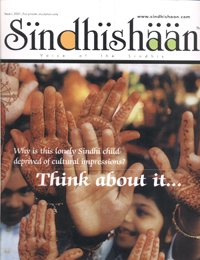REVERBERATIONS OF REVIVAL
By Sanjeev Kutty
On the outskirts of this small town in the United States of America, a group of teenagers of Indian origin dance to the tunes of Punjabi folk songs blaring out of the speakers. The rest of the elderly crowd is also tapping its foot to the beats. The occasion is a Sindhi Sammelan organize by a group of Sindhis in America who behold a strong passion for the community and are eager to resuscitate the culture to glory. Shri Dial Gidwani, President, American Institute of Sindhulogy vociferously says, “It is indeed a great feeling to see the teenagers take interest in a community conglomeration.” “But wouldn’t it be better that the entire program revolves around the Sindhi theme?” he quips. Flashing across a couple of Sindhi music cassettes he says, “Next time there is a Sindhi cultural program in America, I’ll make sure that the music too is Sindhi.” The cassettes are the renditions of traditional Sindhi music, which have been mixed effectively with popular beats, savvy compositions that teenagers can relate to. Like Shri Gidwani, there are many others who echo their feelings about augmenting traditional music with peppier synthesizer melodies, an effervescent mix of pop with folk.
Today, people from different cross-sections still rejoice and dance to the tunes of ‘Jhule Jhule Lal’, by the erstwhile musician Nusrat Fateh Ali, unmindful of the fact that it is a Sindhi folk song. Various other Sufi songs played by groups like Junoon, that are an integral part of Sindhi culture have caught the fancy of the music aficionados. Needless to say, the listeners are still unaware of the origin of the songs and these traditional folk tunes of Sindh are in the eye of a storm, in that, they are facing an acute identity crisis.
Coupled with the identity crisis is the issue of plagiarism that has been omnipresent for years. Plagiarism, which is phrased fancily as inspiration has steadily eaten into traditional music, sounding the death knell for cultural folk tunes. Veteran Sindhi musicians bicker over the elusion of Sindhi music and hold plagiarism responsible for the lull created in the Sindhi music world. A case in point indicating this trend can be culled out from the various Hindi film songs, which were a direct lift from the original Sindhi renditions. Take the example of an old melody sung by a Sindhi artiste Vishni Lal for a Wadia Movie under the directions of Prof. Panjwani. “Badi Bhool Huee Tujhe Pyar Kiya, Tere Vaade Pe Etbar Kiya”. This old composition is popular even today, but Sindhis would not make a demand for that or the original Kohiyari of Sindhi from which it is adopted. Young folks would prefer to hear Nina and Rajendra Mehta in their romantic duet : “Likh Diya Apne Dar Par Kisi Ne, Is Jagah Pyar Karna Manah Hai” But only a select few have responded favourably and emotionally to this Sindhi nagma sung by Master Chander – “Dilbar Je Dar Te Kian Vanja, Dar Te Vanjan Jee Ah Manah.” They, and many of us, may perhaps not know that even a veteran Ustad Bade Ghulam Ali Khan bad been singing Sindhi Kafi and Kohiyari – “Maran Mithryun Galhiryun”. He is known to give a place of prominence to Sindhi Bhairvi in his presentations.
All this cumulates into one concern : Is Sindhi music fading out because of identity crisis and mass-scale plagiarism? Might be true, but what we fail to realize is that there is an opportunity to re-install the lost glory of Sindhi music. Notwithstanding all these, our language has been victim to several adverse circumstances, which have deprived our younger generation of sweetness of their mother tongue. A language that deserves to be proud of its varied vocabulary. There has to be an effort to introduce our children to the lilting melodies of Sindhi Music, through simple words and simple language. ‘Uder Vanj Tun Gera, Vasan Babul Ja Dera’, a song of two or four lettered simple words when set to simple rhythm, is quite catchy and bring listeners to fanciful ecstasy. This is an experiment, which has proved successful throughout the ages. There is dire need to create a cultural and social awakening, and liking for the language, which can come only through music. If one observes, the national non-violent awakening across the borders in Sindh today is not through writings or speeches, which are bit controlled or censored, but through the medium of music. Every singer, while beginning or ending the recitation says in an unforgettable melody “Shal Sindhiri Abaad Rahe” (Long Live Sindh and the Language).
It is the youngsters, the forbearers of the community, who should be made aware of the greatness of Sindhi through the medium of music. In this age of remixes and base resonating-percussion heavy music, would it not be ideal to cater to the youth, with what is likable to them. We have enchanting poets and melodious musicians who have been working hand in glove to produce beautiful compositions that are popular even today across the borders of the country. If these poets and singers pair together to enrich our compositions in simple and easily understandable language, time is not far off when our young folks would sing and dance to their compositions. We will see the language revived again, in shining colours, on the cultural rainbow of the country.


